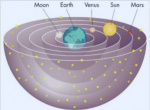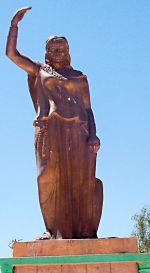This is the portal for Muhammad’s Wives and Consorts
Overview of the portal
- Aisha
- Muhammad's Other wives and consorts
- Muhammad's wives and consorts as examples for the Ummah
The wives of the prophet are described as "أمهات المؤمنين" or "mothers of the believers." As such the prophetic example is considered instructive for all Muslim households. How the prophet interacted with his wives, and how they obeyed him, is a framework for how Muslim husbands and wives ought to interact, as well as how men should interact with their own female slaves. Aisha, the prophet's favorite wife, has an especially loft position in the sacred history of Islam. She was last person the prophet interacted with before he died, and she also form the starting point for many important sahih narrations about his life in the hadith. As such her life is considered especially instructive for Muslim women and believers in general.
Section One
Summary of the first section

The Qur'an mentions a few times that the sun and the moon travel in an orbit (falak - a rounded course), but does not mention once that the Earth does too
The Qur'an mentions a few times that the sun and the moon travel in an orbit (falak - a rounded course), but does not mention once that the Earth does too. This is consistent with an Earth-centered (geocentric) view of the cosmos that places a motionless Earth at the center of the universe and all "heavenly bodies" travel around the Earth. This was the prevailing understanding of the universe prior to the 16th century when Copernicus helped explain and popularize a sun-centered (heliocentric) view of the universe. Tellingly, the sun's orbit is almost always mentioned in the context of night and day (Quran 13:12 being the only exception) and is always mentioned with that of the moon (which does in fact orbit the Earth each month), and the sun's orbit likewise appears, to the unaided eye, to traverse the sky each night when it is visible.
Dihya or Al-Kahina (The Prophetess, Arabic: الكاهنة) was a Berber queen and a religious and military leader who led indigenous resistance to the Muslim conquest of the Maghreb, the region then known as Numidia. She was born in the early 7th century and died around the end of the 7th century in modern-day Algeria.
4Dihya or Al-Kahina (The Prophetess, Arabic: الكاهنة) was a Berber queen and a religious and military leader who led indigenous resistance to the Muslim conquest of the Maghreb, the region then known as Numidia. She was born in the early 7th century and died around the end of the 7th century in modern-day Algeria.
Dihya or Al-Kahina (The Prophetess, Arabic: الكاهنة) was a Berber queen and a religious and military leader who led indigenous resistance to the Muslim conquest of the Maghreb, the region then known as Numidia. She was born in the early 7th century and died around the end of the 7th century in modern-day Algeria.
4Dihya or Al-Kahina (The Prophetess, Arabic: الكاهنة) was a Berber queen and a religious and military leader who led indigenous resistance to the Muslim conquest of the Maghreb, the region then known as Numidia. She was born in the early 7th century and died around the end of the 7th century in modern-day Algeria.
Dihya or Al-Kahina (The Prophetess, Arabic: الكاهنة) was a Berber queen and a religious and military leader who led indigenous resistance to the Muslim conquest of the Maghreb, the region then known as Numidia. She was born in the early 7th century and died around the end of the 7th century in modern-day Algeria.
4Dihya or Al-Kahina (The Prophetess, Arabic: الكاهنة) was a Berber queen and a religious and military leader who led indigenous resistance to the Muslim conquest of the Maghreb, the region then known as Numidia. She was born in the early 7th century and died around the end of the 7th century in modern-day Algeria.

The Qur'an mentions a few times that the sun and the moon travel in an orbit (falak - a rounded course), but does not mention once that the Earth does too
The Qur'an mentions a few times that the sun and the moon travel in an orbit (falak - a rounded course), but does not mention once that the Earth does too. This is consistent with an Earth-centered (geocentric) view of the cosmos that places a motionless Earth at the center of the universe and all "heavenly bodies" travel around the Earth. This was the prevailing understanding of the universe prior to the 16th century when Copernicus helped explain and popularize a sun-centered (heliocentric) view of the universe. Tellingly, the sun's orbit is almost always mentioned in the context of night and day (Quran 13:12 being the only exception) and is always mentioned with that of the moon (which does in fact orbit the Earth each month), and the sun's orbit likewise appears, to the unaided eye, to traverse the sky each night when it is visible.
Section two
Description of section two

The Qur'an mentions a few times that the sun and the moon travel in an orbit (falak - a rounded course), but does not mention once that the Earth does too
The Qur'an mentions a few times that the sun and the moon travel in an orbit (falak - a rounded course), but does not mention once that the Earth does too. This is consistent with an Earth-centered (geocentric) view of the cosmos that places a motionless Earth at the center of the universe and all "heavenly bodies" travel around the Earth. This was the prevailing understanding of the universe prior to the 16th century when Copernicus helped explain and popularize a sun-centered (heliocentric) view of the universe. Tellingly, the sun's orbit is almost always mentioned in the context of night and day (Quran 13:12 being the only exception) and is always mentioned with that of the moon (which does in fact orbit the Earth each month), and the sun's orbit likewise appears, to the unaided eye, to traverse the sky each night when it is visible.
Dihya or Al-Kahina (The Prophetess, Arabic: الكاهنة) was a Berber queen and a religious and military leader who led indigenous resistance to the Muslim conquest of the Maghreb, the region then known as Numidia. She was born in the early 7th century and died around the end of the 7th century in modern-day Algeria.
4Dihya or Al-Kahina (The Prophetess, Arabic: الكاهنة) was a Berber queen and a religious and military leader who led indigenous resistance to the Muslim conquest of the Maghreb, the region then known as Numidia. She was born in the early 7th century and died around the end of the 7th century in modern-day Algeria.
Dihya or Al-Kahina (The Prophetess, Arabic: الكاهنة) was a Berber queen and a religious and military leader who led indigenous resistance to the Muslim conquest of the Maghreb, the region then known as Numidia. She was born in the early 7th century and died around the end of the 7th century in modern-day Algeria.
4Dihya or Al-Kahina (The Prophetess, Arabic: الكاهنة) was a Berber queen and a religious and military leader who led indigenous resistance to the Muslim conquest of the Maghreb, the region then known as Numidia. She was born in the early 7th century and died around the end of the 7th century in modern-day Algeria.
Dihya or Al-Kahina (The Prophetess, Arabic: الكاهنة) was a Berber queen and a religious and military leader who led indigenous resistance to the Muslim conquest of the Maghreb, the region then known as Numidia. She was born in the early 7th century and died around the end of the 7th century in modern-day Algeria.
4Dihya or Al-Kahina (The Prophetess, Arabic: الكاهنة) was a Berber queen and a religious and military leader who led indigenous resistance to the Muslim conquest of the Maghreb, the region then known as Numidia. She was born in the early 7th century and died around the end of the 7th century in modern-day Algeria.

The Qur'an mentions a few times that the sun and the moon travel in an orbit (falak - a rounded course), but does not mention once that the Earth does too
The Qur'an mentions a few times that the sun and the moon travel in an orbit (falak - a rounded course), but does not mention once that the Earth does too. This is consistent with an Earth-centered (geocentric) view of the cosmos that places a motionless Earth at the center of the universe and all "heavenly bodies" travel around the Earth. This was the prevailing understanding of the universe prior to the 16th century when Copernicus helped explain and popularize a sun-centered (heliocentric) view of the universe. Tellingly, the sun's orbit is almost always mentioned in the context of night and day (Quran 13:12 being the only exception) and is always mentioned with that of the moon (which does in fact orbit the Earth each month), and the sun's orbit likewise appears, to the unaided eye, to traverse the sky each night when it is visible.

